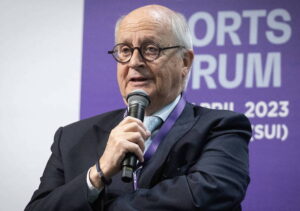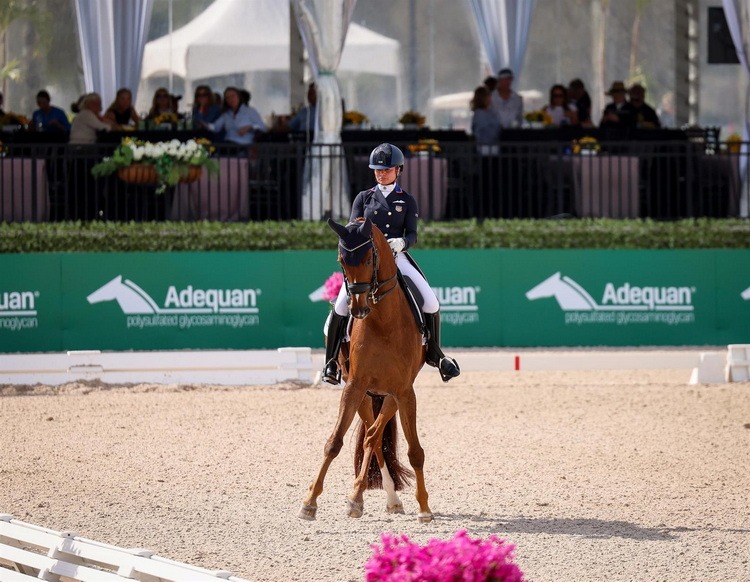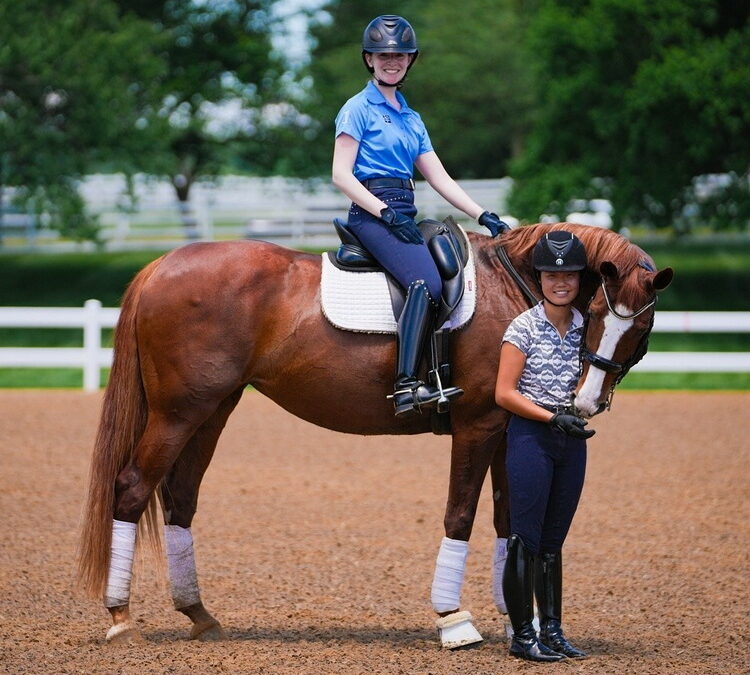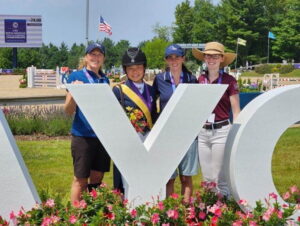by Nancy Jaffer | Feb 21, 2025
The Dutch Party for the Animals (Partij voor de Dieren) contends the Netherlands is taking a big step forward in animal welfare in equestrian sports, following the country’s House of Representative’ vote on a ban involving “animal-unfriendly training aids.”
According to the animal party, “This means that, for example, whips, bits, tongue straps, and spurs with sharp wheels will be prohibited.”
Member of Parliament Christine Teunissen, a representative of the animal group contended, “Thanks to our proposal being passed, the state secretary must introduce a ban on all animal-unfriendly aids and training methods. This means equestrian sports will undergo a radical change.”
She continued, “It has long been known that many `common` training tools for horses are very painful and harmful. The use of a bit causes injuries in the mouth and severely constricts the tongue, often causing it to turn blue. The use of whips also causes a lot of animal suffering. No animal should have to endure this. That is why we are incredibly happy that Parliament demands a ban on these tools. A fantastic step forward! ”
Or is it? The Dutch federation did not respond to requests for comment, but an article in Horse & Hound noted “questions remain over what exactly will be restricted and how the rules will be enforced.”
Stakeholders, including horse-oriented organizations, must be consulted by the government before regulations are drafted.
One commenter noted, “Focus on education instead of bans.”

by Nancy Jaffer | Feb 21, 2025
An innovative arrangement to spearhead the USA’s high performance three-day eventing efforts will be led by Leslie Law, who has been serving as the country’s eventing development coach. He becomes the team’s chef d’equipe while taking on the role of high performance manager for the Defender U.S. Eventing Team, working with Karyn Shuter. She fills a newly created spot as U.S. Eventing high performance adviser.
Leslie earned the 2004 Olympic individual eventing gold medal in Athens, where he also was a team silver medalist for his native Great Britain. In the chef role, he succeeds Bobby Costello, who did not seek renewal of his contract after it expired last November.

Leslie Law on the podium at the Athens Olympics, where he won individual gold and team silver. (Photo © 2004 by Nancy Jaffer)
Karyn evented for New Zealand, but is best known for working with Britain’s former world number one eventer, Oliver Townend. In his words, she has done “everything—entries, bills, owners, sponsors, riding and training” for approximately 15 years.
She is one of the owners of Ballaghmor Class, the horse on whom Oliver has won the Defender Kentucky 5-star and most recently the Maryland 5-star.
In addition to working with Oli, “She has helped other athletes,” said Hallye Griffin, the USEF’s director of FEI/High Performance Sport.
While Karyn may also be helping those athletes elswhere on occasion, Hallye said USEF conflict of interest policies will apply, which means “when she’s working for us, she’s working for us. There will be times when she is not working for us,” which means she will have “an allowance to advise others” in those instances.
Hallye noted the eventing leadership selection process was “extremely athlete-driven,” saying they are “really, really excited about Karyn coming on board along with Leslie.”
She added, “The athletes were a big piece of this… (they) were really driving this process. When it came down to it, it was, you know what? We think we need two people.” Looking at other countries, Hallye pointed out, “having more than one person (in a leadership position) is not uncommon.”
Tamie Smith, who in 2023 became the first U.S. rider to win the Kentucky 5-star since 2008, noted that “As riders, we are very excited with the selection of Leslie Law and Karyn Shuter as the leaders for our high-performance goals.
“After an extensive and thoughtful evaluation process, we believe their combined expertise and passion will inspire our team to achieve new heights. We extend our gratitude to USEF for their support and for allowing us to be a part of this process.”
While Leslie has “so much knowledge of the talent of the U.S. and our operations and the programs and the athletes and the horses,” Hallye said, “Karyn is going to come in with a slightly different outside perspective and have a lot of insights into what some of the other top athletes around the world are doing, and seeing where we can increase or level up our programs to get some extra edge for the future.”
Karyn is based in the United Kingdom, but she will be traveling to the U.S. for various events,, home visits and other occasions.
Added Hallye, “There is a lot that is still evolving. This is a re-structure for us to have a high performance advisor. She and Leslie and our athletes have all been super honest with understanding there might be some things within job descriptions that have to evolve.
“As they get their footing, Leslie and Karyn really have to get feedback from everyone as to where these programs need to be going. They’re both excited to have a team of people here.”
Leslie, who has continued to compete in recent years, noted that “Having supported the USEF eventing programs and teams for more than a decade, I have a clear understanding of our depth of talent and ability. I’m honored the athletes supported this transition and are confident in this new structure. With Karyn coming into the fold, alongside our program staff, we are starting this new quad heading in the right direction with the same collective goals in mind.”
“Having supported the USEF eventing programs and teams for more than a decade, I have a clear understanding of our depth of talent and ability,” said Leslie.
“I’m honored the athletes supported this transition and are confident in this new structure. With Karyn coming into the fold alongside our program staff, we are starting this new quad (quadrennium) heading in the right direction with the same collective goals in mind.”
For her part, Karyn stated, “The U.S. has a longstanding and successful history in the sport of eventing and a lot of untapped potential. I’m looking forward to the future with this program and to contributing to supporting the athletes and identifying ways we can improve performance at the international and championship levels.”
Shuter will work with athletes and stakeholders on performance plans, while supporting Leslie in developing a long-term strategy to produce sustained success. It’s all about strategy in their case, since neither of the positions involve training roles.
Christina Vaughn, who worked with Leslie on the eventing development programs for the past decade, will become USEF eventing elite program director and team leader. Leslie and Karyn will report to Amber Braun, USEF’s managing director of eventing.

by Nancy Jaffer | Feb 25, 2025
The influential president of the European Equestrian Federation, Theo Ploegmakers, will leave his position April 1 due to health issues after nearly seven years in the role.
Founded in 2009, the EEF is the representative body for the European-based national equestrian federations. Working closely with the Federation Internationale Equestre (FEI) and the national federations, the EEF works to maximize the potential and development of equestrianism throughout the continent. It is committed to promoting the sport and its good practices, developing it across Europe, and providing leadership for a collective European voice. The EEF board will determine who succeeds Theo in the presidency.

Theo Ploegmakers (Photo © FEI/Richard Juilliart)
The former president of the Dutch federation looked back on his tenure, noting, “We have successfully united the European equestrian community, fostering meaningful cooperation between both large and small federations. Today, the federation stands as a testament to what can be achieved through shared vision and collaboration.
“When I became president, my vision was not only to create better opportunities for all European nations but also to ensure that our sport’s growth never compromised horse welfare,” he said.
“We have built a stronger, more inclusive community where competitive success aligns with a principled approach to horsemanship. I depart knowing that we have elevated both our achievements and our values. The foundation we have established will continue to benefit European equestrianism for generations to come.”
As part of his dedication to equine welfare, his involvement has supported efforts to promote responsible practices and maintain public trust in equestrianism’s social license to operate.
by Nancy Jaffer | Feb 18, 2025
The U.S. Center for SafeSport is being called on by a U.S. senator to explain the circumstances involved in hiring an investigator who faces criminal charges, including rape and theft.
The non-profit Center was authorized by Congress in 2017 with the goal of ending sexual, physical and emotional abuse involving athletes in the Olympic and Paralympic movement, in the wake of a sex scandal centered on U.S. gymnastics team doctor Larry Nassar. There are dozens of equestrians’ names on SafeSport’s centralized disciplinary database, with most offenses listed including sexual misconduct involving a minor.
As Sen. Chuck Grassley (R-Iowa) noted this month in his letter to SafeSport CEO Ju’Riese Colón, “Accusations of rape and other sex crimes against any SafeSport investigator are especially concerning given SafeSport’s mandate to protect athletes from similar abuse.
“Charges of that nature seriously call into question the quality of SafeSport’s vetting of its own officials.”
Former Safe Sport investigator Jason Krasley, who was hired by the Center in 2021, is charged with stealing $5,500 from a crime suspect in 2019 when he was a detective in the Allentown, Pa., police department. He was arraigned Nov. 15, 2024’s in Lehigh County, Pa.’s Magisterial District Court on charges of theft, receiving stolen property and fabricating evidence. SafeSport fired him that month.
In his letter, Grassley went on to state that Krasley was working for SafeSport when he allegedly subjected an individual to harassing physical contact on June 14, 2024.
“He reportedly threatened his victim and used words lewd to the point of being criminal. This was not the first time Mr. Krasley purportedly engaged in misconduct. In 2015, he allegedly raped an individual `by threat of forcible compulsion.’ He was arraigned on this and other charges on December 19, 2024,” according to the senator’s letter.
Krasley’s attorney did not respond to requests for comment.
Citing other charges dating back to 2015 on which Krasley was arraigned in January 2025, Grassley seeks to know not only what information SafeSport had about Krasley, but also details of the Center’s hiring practices.
“Claimants share deeply personal information with SafeSport investigators. For some, the memories they share with SafeSport are among their worst.”
The Senator pointed out they deserve to deal with fair investigators who have not been accused of sexual misconduct.
An independent third-party firm is auditing Krasley’s cases to ensure fairness and adherence to the Center’s investigative protocol.
With guidance from trauma-informed experts, the Center is reaching out to both claimants and respondents in Krasley’s cases to inform them of the audit and how to contact the outside firm, as well as accessing additional support.
Grassley gave SafeSport until March 10 to respond to a series of 13 questions, including details of a new morals clause being added to the Center’s code of conduct. He also wants to know more about the Krasley situation, including how the investigations with which the former investigator was involved are being handled in the wake of his firing.
SafeSport is in the process of responding to the senator. Asked for a request for comment, the Center stated it “commissions a thorough background check on all prospective employees using a national background check provider. The checks include multiple levels of screening related to criminal and sex offender registry history and is repeated annually for all active employees. In addition, the Center conducts multiple interviews, reference reviews and investigates whether anyone has been a respondent in our process.
“The Center takes this matter seriously and is assessing the situation to determine what, if any, additional vetting could have prevented this individual from being eligible for hire. One initial step the Center is taking is adding language akin to a morals clause to the employee Code of Conduct.”
Colón said, “I am appalled that a former staff member has been accused of such heinous acts in his previous role as a police officer. We hold all staff to the highest standard because safeguarding athletes is our utmost priority.”
Legislation introduced at the end of last year would give SafeSport an additional $10 million in federal grants for training and education programs if it passed. The Center already receives $2.5 million from the government, and the remainder of its $20 million budget comes from Olympic and Paralympic sports’ governing bodies.

by Nancy Jaffer | Feb 20, 2025
For the fifth straight time since the FEI Dressage Nations Cup began in Wellington, Fla., in 2013, Germany took the title in the Starpoint Dancesport team competition that drew squads from five countries on Thursday.
Germany earned 207.022 points while silver went to the Dutta Corp. U.S. team with 201.565 points. Sweden’s 190.761 points earned bronze.
Individually, Germany’s Evelyn Eger was first with a new personal best of 70.435% on Tabledance 3, a daughter of Totilas. Swedish Olympic veteran Tinne Vilhelmsen Silfven was second with 70.304 percent on Hyatt. The top two were the only riders to break 70 percent.
The best American score belonged to Devon Kane on Vamos, fifth with 67.435 percent. Her husband, Kevin Kohmann, was right behind her on Giulietta with 67.304.

Devon Kane and Vamos, the top-scoring U.S. combination. (©Avery Wallace/US Equestrian)
After a rough beginning, where Devon thought her distracted horse started trending on 22 percent, the combination “pulled our way up from there, so I knew we had to catch as many points as we could and make every movement count,” she said. “I’m proud that my horse was able to overcome such a setback.
“It’s an honor to be able to represent the U.S. at any Nations Cup, but to do so with your husband next to you, cheering for you and riding with you is extremely special,” added Devon, who was helped into her new team jacket by her husband before the class..
She produced both Vamos and Giulietta from young horses, and noted having them be part of the team is “a testament to our commitment to the sport and to helping each other and our team do well.
“This is both Vamos and Giulietta’s first year of CDI, so to be trusted for the U.S. team and to do what we did today makes us very proud. Today was very special.”
Germany’s chef d’equipe, Michael Klimke, also rode on the squad, but noted his horse wasn’t at his best. The other riders made up for it, however.
“Team spirit is very important, and we all have the feeling we can rely on and trust each other,” Michael explained.
Australia and Canada also participated, but as they had only three members on their teams, and each had one rider who was eliminated, their scores did not count.
In the 3-star Starpoint Dancesport FEI freestyle Friday night at the Adequan Global Dressage Festival, Evelyn was again the winner with a personal best of 77.235 percent to tunes by Shakira. Evelyn, who rides for Hof Kasselman, has ridden 12-year-old Tabledance since she was seven and brought her up through the levels.
Another German rider, Felicitas Hendricks on Drombusch OLD, earned silver with a total of 75.13 percent. She rode to disco music; the only wrinkle in the performance was a kick out on the final centerline.
Devon, who led the U.S. silver medal team placing on Thursday, took bronze on Vamos with a very close score of 75.125.
“This is our third freestyle under the lights, and when he walks out at night, he walks out different,” said Devon, whose music was techno swing from the Gatsby movie.
“He really enjoys the dancing and the music and he knows exactly what’s happening. He lights up and he’s game-on from the start.”
The class was a qualifer for the new U.S. Equestrian Open of Dressage, which has a final in November. Click here for team results; click this link for freestyle results.

by Nancy Jaffer | Feb 20, 2025
Trainer/rider Nicole DelGiorno is concerned about why more children and young people aren’t riding dressage in the U.S., even as the hunter/jumper/hunt seat equitation ranks are crammed with kids.
A four-time North American Youth Championships medalist and board member of the Dressage Foundation, Dressage4Kids and Dressage at Devon, she began her learning process with the U.S. Pony Club. Nicole, whose specialty involves developing youth riders and young professionals, is a U.S. Dressage Federation Bronze, Silver and Gold medalist. She also has served as chef d’equipe for Children’s and Junior teams.
She took to social media to diagnose the problem, airing her thoughts on why more U.S. kids aren’t riding dressage. It goes without saying that it is important to have young people coming up through the pipeline so eventually they can represent their country at championships, such as the Olympics. The grassroots are key.
“My goal is to start the conversation,” Nicole told me. While some people do discuss the subject, she believes “it’s a matter of everyone coming together deciding what the right course of action is.” She mentioned that without reinventing the wheel, “There are so many great examples,” to provide inspiration, such as what the American Quarter Horse Association does for its kids.
While some USDF GMO’s (Group Member Organizations) offer age-appropriate schooling show competitions, Nicole noted that is “really dependent on your local GMO and how active and creative they are.” One bright spot in USDF’s Region 1 ((Delaware, Maryland, New Jersey, North Carolina, Pennsylvania, and Virginia) is Lendon Gray’s Youth Festival for riders 25 and under, to be held Aug. 8-10 at the Horse Park of New Jersey. The only other similar festival, according to Nicole, is in Georgia.
Nicole, who is based in New Jersey, offers some intriguing insights. She contends “the recognized youth divisions in U.S. dressage are structured terribly, and that is definitively why we cannot get more kids in dressage.”

Nicole with her former student and current assistant, Quinn Ridgway, at the North American Youth Championships with Quinn’s family.
She illustrated the situation with this theoretical example:
“You are a non-horse parent with a 6-year-old kid that loves horses. You type `horseback riding lessons near me’ into a search engine and start investigating. Ninety percent of the programs that show up offer instruction in hunt seat equitation. Must be popular! You see that the highest-rated barn offers a summer camp and you decide to send your child. She loves it and starts making friends with the kids who ride at the barn. She begs for weekly riding lessons. She takes lessons one to two days a week until her trainer mentions that she is really getting quite good. She should start to compete.
“She does the leadline division and gets exposed to an environment like the Devon Horse Show. Dreams ablaze in her heart, she asks if she can have a pony of her own, but your family isn’t ready for that type of commitment.
`No worries,’ says the trainer. `You can lease our small pony.’ Then she ages out and you lease the medium pony…or the large pony… or the junior hunter.
“But at some point, your kid is getting quite good and the trainer helps you buy a competitive A-circuit equitation horse. Your daughter goes on to place well at several big championships, catching the attention of a noted trainer who offers to take her on as a rider. She goes on to become an assistant trainer, or to cruise happily around the amateur divisions. The End.”
Nicole observed that storyline involves, “Everything curated. Everything clear. Their goal is to not overwhelm parents, because there is real money in developing youth riders in hunter/jumper land and real milestones to attain from the time the kids are little. When that’s true, the trainers are happy and structure their programs to make parents and children happy.
“Now, let’s say your first call was to a dressage barn,” Nicole continued.
“Nine times out of ten, that conversation is going to go like this: `Hello! I am inquiring about riding lessons for my 6-year-old daughter.’ ….`Hi! Does she have her own horse?’ …`No, we don’t.’ `Sorry, can’t help you.’”
Nicole goes on to illustrate another scenario, in which the parent calls one of the 10 percent of dressage barns that can accommodate beginner children.
“Your kid takes riding lessons there for two years. In her third year, she might do some dressage schooling shows at Introductory Level. Your trainer may even take her to some unrated hunter/jumper shows because the format is easier, cheaper and she can get more ring time. Next year, your kid begs to show recognized at Training Level. At only 10 years old, she really does quite well on the barn’s lesson pony. She qualifies for Regional Championships.
Continuing, Nicole suggested, “When you arrive in the warmup for your first class, you see your child’s eyes widen to saucers. She rides over to her trainer and asks in hushed tones, `Is SHE in my class?’
`Yes, my dear, SHE is.’ Your eyes slide over to the 21-year-old rising professional riding her client’s young horse, who appears to be the second coming of Glamourdale. The class commences. Your kid rides her heart out on her lesson pony (you had tried to find something nice for her to lease for this year, but no luck finding a quality seasoned dressage pony for lease). Still, even with her best test of the year, she places third to last with a 62 percent. The young pro wins with a 74 percent. Not because your kid isn’t great and skilled for her age, but because there is a chasm in terms of experience and physical ability between a 10-year-old and a 21-year-old.

Nicole DelGiorno with her former student Quinn Ridgway, who is now her assistant. (Photo by Priceless Equine Productions)
“This is what it is going to look like for the next few years until you buck up and buy a pony for her to do FEI Children’s or Ponies (probably from Europe, because that’s the only place to reliably find a competitive pony that’s actually been shown and proven by a kid). Sure, you could aim at Dressage Seat Equitation Medal Finals, which has a 13 and under division… if you have one of the few 10-year-olds who can ride First Level inside out and backwards, and you can find a size-appropriate mount for her to do it on.”’
She suggested splitting Youth Division classes at Second Level and below according to the rider’s age, noting it wouldn’t cost more than few extra sets of ribbons.
For Dressage Seat Equitation, her idea is a Walk-Trot Equitation class aimed at beginner riders with an Introductory skill set; Walk-Trot-Canter aimed at novice riders with a Training Level skill set and then Advanced Equitation.
It “would keep the current standards for riders with a First Level skill set and feed into the Dressage Seat Medal Finals.” Nicole also would like to see a Pony Division split according to size.
To read more of her suggestions, click here.
The problem, as Nicole sees it, is that “In general, we do NOT provide the Disney experience to families like the hunter/jumper community does. We do not structure our divisions to give kids appropriate milestones (Why not have an equitation class that is just Walk/Trot like they do in hunter/jumper land? Why can’t we get out of our own way and reward correct basics without making the kids do leg yield, zig-zags and counter-canter and three changes of lead through trot on the diagonal?)
“Because the way our youth divisions are structured is so challenging, no trainer really wants to structure their business around it. It’s a bad gamble that will almost assuredly result in a ticked-off parent and a disappointed kid. Much easier to help adult amateurs…pursue their medals.”
She emphasizes what is at stake for the discipline: “We want to see more kids riding dressage. We want to see better horsemanship and depth at every level of the sport. Then where is the space for younger riders to compete, learn and connect with their peers? Where are the milestones for them to aim toward?”

Nicole riding at Yeguada Susaeta. (Photo by Maria Ruiz Fernandez)
Nicole feels it’s crucial to address these issues, mentioning the concept of a USDF task force that could examine the subject and come up with ideas.
“Until we have an outlet for these young kids to showcase their skill and test their ability in classes that are structured fairly, I think we are going to continue scratching our heads and wondering, `Where are the dressage kids?’ ”
Anyone who thinks they have answers and wants to continue the conversation Nicole started may contact her at nicole.delgiorno@gmail.com.











